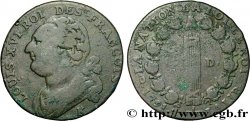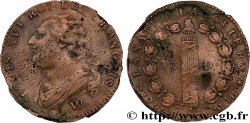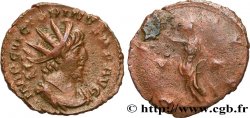E-auction 608-584775 - fme_888587 - LOUIS XVI Médaille, Général de La Fayette, refrappe
Usted debe firmar y ser un comprador aprobado para pujar, Inicia sesión para pujar. Las cuentas están sujetas a la aprobación y el proceso de aprobación se alcanzan dentro de las 48 horas. No espere hasta el día en una venta se cierra el registro.Al hacer una oferta en este artículo usted está firmando un contrato jurídicamente vinculante para comprar este artículo y haga clic en «oferta» constituye una aceptación de los términos de uso de e-auctions de cgb.fr.
La subasta debe ser colocado en euros enteros cantidades venta only.The se cerrará en el momento en la descripción del artículo, no se ejecutarán las ofertas recibidas en el sitio después de la hora de cierre. Veces Transmition pueden variar y las ofertas pueden ser rechazadas si espera a los últimos segundos. Para más información envie el FAQ.
SIN GASTOS PARA LOS COMPRADORES.
SIN GASTOS PARA LOS COMPRADORES.
| Valoración : | 65 € |
| Precio : | 48 € |
| Oferta más alta : | 53 € |
| Fecha de fin de la venta : | 09 diciembre 2024 20:53:40 |
| participantes : | 7 participantes |
Tipo : Médaille, Général de La Fayette, refrappe
Fecha: (1789)
Metal: bronce
Diámetro: 41,5 mm
Eje de acuñación: 12 h.
Peso: 28,28 g.
Canto: lisse + corne BRONZE
Cuño: corne BRONZE
Comentarios sobre el estado de conservación:
Patine hétérogène, présentant des taches d’oxydation et des concrétions dans le creux de certains reliefs
Anverso
Titulatura del anverso: M. P. J. R. I. G. MOTIER MQUIS DE LA FAYETTE NÉ LE 6 SEPT. 1757 // OFFERT PAR E. DUVIVIER / A LA GARDE NATION-AL.
Descripción del anverso: Buste à gauche du général de La Fayette.
Reverso
Titulatura del reverso: VENGEUR DE LA LIBERTÉ DANS LES DEUX MONDES // (...).
Descripción del reverso: Légende circulaire et in 11 lignes horizontales.
Comentario
Gilbert du Motier, marquis de La Fayette, dit « La Fayette », né le 6 septembre 1757 au château de Chavaniac, paroisse de Saint-Georges-d'Aurac (province d'Auvergne, actuellement Chavaniac-Lafayette dans la Haute-Loire) et mort le 20 mai 1834 à Paris (ancien 1er arrondissement), est un noble d'orientation libérale, officier et homme politique français. Nommé général par George Washington, Lafayette a joué un rôle décisif aux côtés des Américains dans leur guerre d'indépendance contre le pouvoir colonial britannique et en particulier lors de la victoire de Yorktown le 19 octobre 1781. Lafayette a aussi œuvré à l'émergence en France d'un pouvoir royal moderne, avant de devenir une personnalité de la Révolution française jusqu'à son émigration, son arrestation et sa mise en prison pour cinq ans en 1792. Lafayette fut aussi un acteur politique majeur des débuts de la monarchie de Juillet. Surnommé le « héros des deux mondes », il est l'un des huit citoyens d'honneur des États-Unis d'Amérique.
Après la révolution de 1789, La Fayette décide de signer tous ses courriers d'un « Lafayette » en un seul mot, en réaction contre le système nobiliaire. C'est aussi la graphie utilisée par ses contemporains jusqu'à sa mort.
Gilbert du Motier, Marquis de La Fayette, known as \\\"La Fayette\\\", born on September 6, 1757 at the Château de Chavaniac, parish of Saint-Georges-d'Aurac (province of Auvergne, currently Chavaniac-Lafayette in Haute-Loire) and died on May 20, 1834 in Paris (former 1st arrondissement), was a nobleman of liberal orientation, officer and French politician. Appointed general by George Washington, Lafayette played a decisive role alongside the Americans in their war of independence against the British colonial power and in particular during the victory at Yorktown on October 19, 1781.. Lafayette also worked towards the emergence of a modern royal power in France, before becoming a figure of the French Revolution until his emigration, arrest and imprisonment for five years in 1792.. Lafayette was also a major political player in the early days of the July Monarchy.. Nicknamed the \\\"hero of two worlds,\\\" he is one of eight honorary citizens of the United States of America..
After the revolution of 1789, Lafayette decided to sign all his letters with a single word \\\"Lafayette\\\", in reaction against the nobility system.. This is also the spelling used by his contemporaries until his death.
Après la révolution de 1789, La Fayette décide de signer tous ses courriers d'un « Lafayette » en un seul mot, en réaction contre le système nobiliaire. C'est aussi la graphie utilisée par ses contemporains jusqu'à sa mort.
Gilbert du Motier, Marquis de La Fayette, known as \\\"La Fayette\\\", born on September 6, 1757 at the Château de Chavaniac, parish of Saint-Georges-d'Aurac (province of Auvergne, currently Chavaniac-Lafayette in Haute-Loire) and died on May 20, 1834 in Paris (former 1st arrondissement), was a nobleman of liberal orientation, officer and French politician. Appointed general by George Washington, Lafayette played a decisive role alongside the Americans in their war of independence against the British colonial power and in particular during the victory at Yorktown on October 19, 1781.. Lafayette also worked towards the emergence of a modern royal power in France, before becoming a figure of the French Revolution until his emigration, arrest and imprisonment for five years in 1792.. Lafayette was also a major political player in the early days of the July Monarchy.. Nicknamed the \\\"hero of two worlds,\\\" he is one of eight honorary citizens of the United States of America..
After the revolution of 1789, Lafayette decided to sign all his letters with a single word \\\"Lafayette\\\", in reaction against the nobility system.. This is also the spelling used by his contemporaries until his death.








 Informar de un error
Informar de un error Imprimir la página
Imprimir la página Comparte mi selección
Comparte mi selección Haz una pregunta
Haz una pregunta Consignar / vender
Consignar / vender
 Descriptivo
Descriptivo










